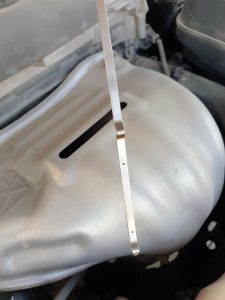Like an engine, vehicle transmission requires lubricating oil for protection against wear and tears, long service life, and smooth shifting of gears. Vehicles have two types of gearboxes, manual and automatic. Check the transmission fluid type precisely. Manual transmission takes gear oil that is high viscosity GL-4 or GL-5 service depending upon the model and manufacturer of the vehicle. On the other hand, automatic transmission needs an automatic transmission fluid (ATF) like DEX III, DEX VI, Toyota T4, etc. There are many types of ATF (automatic transmission fluid), so be very precise before top-up or oil change. ATF is usually cherry-red or green to distinguish it from the engine oil. Consult the vehicle manual if in doubt. The wrong fluid can lead to costly repairs and may destroy the transmission.
How to check the transmission fluid level?
Step 1: Locate the “Red” dipstick
Park your vehicle on level ground, leave the engine running, gear handle at P (Park) position, and apply the parking brake. Locate the dipstick to check the automatic transmission fluid level. ATF dipstick has a red loop or a red oval handle, while engine oil dipstick is usually yellow or white. In rear-wheel-drive vehicles, find the dipstick at the back of the engine near the passenger compartment wall. In the front-wheel drive, the dipstick is at the driver end, close to the side of the transmission. Make sure that you are checking the transmission oil level, not the engine oil.
Step 2: Check transmission oil level
Pull the dipstick out, wipe it with a clean cloth or paper towel. Wipe the end of the dipstick, push it back into the stalk again. Make sure it is inserted fully into the position. There is an edge close to the metal loop to indicate the seating. Wait a few seconds and remove the dipstick again to determine the oil level.
Step 3: Read the dipstick
At the end of the dipstick, check the oil reach. Look for the fluid mark to determine where the oil ends. Find the markings that indicate the L (low) and F (Full) levels. Sometimes there are lines for “Full and Low” with a cross-hatched area between the two. The reach of fluid must end between the two marks. It is recommended and considered good if the transmission fluid level is close to the upper F (Full) mark.
Step 4: Check the condition of transmission fluid
Transmission fluid is usually cherry red or green, semi-transparent, with no burnt smell. ATF must be free from contamination like debris, dust, dirt, and metal shaving. If the color is dark red, brown, or blackish and smells burnt, change the transmission fluid Immediately and consult a certified service center for transmission check-up and maintenance. You may have to change a filter along with the transmission fluid. Contaminated fluid may lead to costly repairs.
Trending
- NLGI Grease Consistency, Classifications and ApplicationsLubricating grease consistency A grease consistency or penetration score indicates… Read more: NLGI Grease Consistency, Classifications and Applications
- Calcium Grease: Composition, Formulations, and ApplicationsCalcium Soap Greases: Tallow (animal fat) based calcium greases were… Read more: Calcium Grease: Composition, Formulations, and Applications
- Lithium Grease: Composition, Formulations, and ApplicationsLithium grease is widely regarded as one of the most… Read more: Lithium Grease: Composition, Formulations, and Applications
- Mixing Viscosity (Blending) CalculatorMixing Viscosities Calculator: To predict blend viscosity of two or… Read more: Mixing Viscosity (Blending) Calculator

How to Check Transmission Fluid Without Dipstick
Some models of transmissions have the facility to check the transmission fluid level with a dipstick. Modern automatic transmissions are factory filled with no provision for level check or fluid top-up. Modern automatic transmissions have an electronic sensor to indicate fluid level or low oil level. In the event of low fluid, a service center or a garage can fill or top-up the transmission fluid. Similarly, you can’t check the fluid level in manual transmission. Manual transmissions are factory filled and sealed. Usually, to find the transmission fluid level, you must remove a plug underneath a car. Only a service center or garage can check the transmission fluid level if there is an oil leak or repair. Average vehicles owners don’t have the facility and skills required to check the transmission oil level in transmission without a dipstick
How to add transmission fluid
In an automatic transmission with a dipstick, top up the transmission fluid through the dipstick stalk or tube where the dipstick fits. Use a narrow funnel with a long spout that fits in the small dipstick tube. Always use manufacturer-recommended automatic transmission fluid (ATF). Add a small quantity (a few hundred ml) and check the fluid level with a dipstick until the oil level is at the full mark.
Signs of low transmission fluid
1- Grinding or whining: Grinding noises from manual transmission during shifting gears. While automatic transmission sounds like it’s whining or humming.
2- The burning smell from the fluid can be a sign of a low level of transmission fluid.
3- Oil leaking is a common cause of low oil levels. Check for red fluid drops underneath the vehicle after overnight parking.
4- Slipping gears while driving



